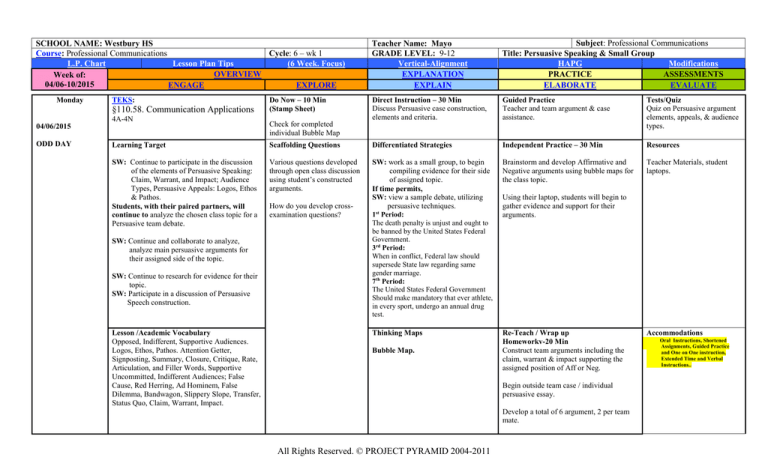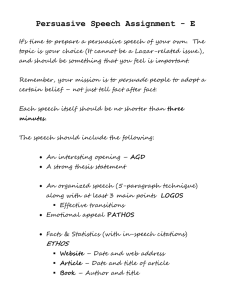
SCHOOL NAME: Westbury HS
Course: Professional Communications
Cycle: 6 – wk 1
L.P. Chart
Lesson Plan Tips
(6 Week. Focus)
OVERVIEW
Week of:
04/06-10/2015
ENGAGE
EXPLORE
Monday
TEKS:
§110.58. Communication Applications
4A-4N
04/06/2015
ODD DAY
Do Now – 10 Min
(Stamp Sheet)
Teacher Name: Mayo
GRADE LEVEL: 9-12
Vertical-Alignment
EXPLANATION
EXPLAIN
Subject: Professional Communications
Title: Persuasive Speaking & Small Group
HAPG
Modifications
PRACTICE
ASSESSMENTS
ELABORATE
EVALUATE
Direct Instruction – 30 Min
Discuss Persuasive case construction,
elements and criteria.
Guided Practice
Teacher and team argument & case
assistance.
Tests/Quiz
Quiz on Persuasive argument
elements, appeals, & audience
types.
Check for completed
individual Bubble Map
Learning Target
Scaffolding Questions
Differentiated Strategies
Independent Practice – 30 Min
Resources
SW: Continue to participate in the discussion
of the elements of Persuasive Speaking:
Claim, Warrant, and Impact; Audience
Types, Persuasive Appeals: Logos, Ethos
& Pathos.
Students, with their paired partners, will
continue to analyze the chosen class topic for a
Persuasive team debate.
Various questions developed
through open class discussion
using student’s constructed
arguments.
SW: work as a small group, to begin
compiling evidence for their side
of assigned topic.
If time permits,
SW: view a sample debate, utilizing
persuasive techniques.
1st Period:
The death penalty is unjust and ought to
be banned by the United States Federal
Government.
3rd Period:
When in conflict, Federal law should
supersede State law regarding same
gender marriage.
7th Period:
The United States Federal Government
Should make mandatory that ever athlete,
in every sport, undergo an annual drug
test.
Brainstorm and develop Affirmative and
Negative arguments using bubble maps for
the class topic.
Teacher Materials, student
laptops.
Thinking Maps
Re-Teach / Wrap up
Homeworkv-20 Min
Construct team arguments including the
claim, warrant & impact supporting the
assigned position of Aff or Neg.
SW: Continue and collaborate to analyze,
analyze main persuasive arguments for
their assigned side of the topic.
SW: Continue to research for evidence for their
topic.
SW: Participate in a discussion of Persuasive
Speech construction.
Lesson /Academic Vocabulary
Opposed, Indifferent, Supportive Audiences.
Logos, Ethos, Pathos. Attention Getter,
Signposting, Summary, Closure, Critique, Rate,
Articulation, and Filler Words, Supportive
Uncommitted, Indifferent Audiences; False
Cause, Red Herring, Ad Hominem, False
Dilemma, Bandwagon, Slippery Slope, Transfer,
Status Quo, Claim, Warrant, Impact.
How do you develop crossexamination questions?
Bubble Map.
Using their laptop, students will begin to
gather evidence and support for their
arguments.
Begin outside team case / individual
persuasive essay.
Develop a total of 6 argument, 2 per team
mate.
All Rights Reserved. © PROJECT PYRAMID 2004-2011
Accommodations
Oral Instructions, Shortened
Assignments, Guided Practice
and One on One instruction,
Extended Time and Verbal
Instructions..
Tuesday
TEKS:
§110.58. Communication Applications
Do Now – 10 Min
(Stamp Sheet)
4A -4N
04/07/2015
EVEN DAY
Learning Target
SW: Continue to participate in the discussion
of the elements of Persuasive Speaking:
Claim, Warrant, and Impact; Audience
Types, Persuasive Appeals: Logos, Ethos
& Pathos.
Students, with their paired partners, will
continue to analyze the chosen class topic for a
Persuasive team debate.
SW: Continue and collaborate to analyze,
analyze main persuasive arguments for
their assigned side of the topic.
SW: Continue to research for evidence for their
topic.
SW: Participate in a discussion of Persuasive
Speech construction.
Lesson /Academic Vocabulary
Opposed, Indifferent, Supportive Audiences.
Logos, Ethos, Pathos. Attention Getter,
Signposting, Summary, Closure, Critique, Rate,
Articulation, and Filler Words, Supportive
Uncommitted, Indifferent Audiences; False
Cause, Red Herring, Ad Hominem, False
Dilemma, Bandwagon, Slippery Slope, Transfer,
Status Quo, Claim, Warrant, Impact.
Check for completed
individual Bubble Map
Scaffolding Questions
Various questions developed
through open class discussion
using student’s constructed
arguments.
How do you develop crossexamination questions?
Direct Instruction – 30 Min
Discuss Persuasive case construction,
elements and criteria.
Guided Practice
Teacher and team argument & case
assistance.
Tests/Quiz
Quiz on Persuasive argument
elements, appeals, & audience
types.
Differentiated Strategies.
Independent Practice – 30 Min
Resources.
Students will write specified persuasive
terms and definitions.
Brainstorm and develop Affirmative and
Negative arguments using bubble maps for
the class topic.
Teacher Materials, student
laptops.
SW: work as a small group, to begin
compiling evidence for their side
of assigned topic.
If time permits,
SW: view a sample debate, utilizing
persuasive techniques.
Using their laptop, students will begin to
gather evidence and support for their
arguments.
Complete persuasive notes using note sheet
handout.
4th Period:
Institutions of higher learning should
waive tuition fees for people who
qualify.
6th Period:
The United States Federal Government
should allow Americans, who qualify,
to pay reduced taxes.
Thinking Maps
Re-Teach / Wrap up
Homeworkv-20 Min
Bubble Map
Construct team arguments including the
claim, warrant & impact supporting the
assigned position of Aff or Neg.
Begin outside team case / individual
persuasive essay.
Develop a total of 6 argument, 2 per team
mate.
All Rights Reserved. © PROJECT PYRAMID 2004-2011
Accommodations
Oral Instructions, Shortened
Assignments, Guided Practice
and One on One instruction,
Extended Time and Verbal
Instructions.
Wednesday
TEKS:
§110.58. Communication Applications
4A -4N
04/08/2015
ODD DAY
Learning Target
SW: Continue to participate in the discussion
of the elements of Persuasive Speaking:
Claim, Warrant, and Impact; Audience
Types, Persuasive Appeals: Logos, Ethos
& Pathos.
Students, with their paired partners, will
continue to analyze the chosen class topic for a
Persuasive team debate.
SW: Continue and collaborate to analyze,
analyze main persuasive arguments for
their assigned side of the topic.
SW: Continue to research for evidence for their
topic.
SW: Participate in a discussion of Persuasive
Speech construction.
SW: View various scenes from the “Great
Debaters.”
Lesson /Academic Vocabulary
Opposed, Indifferent, Supportive Audiences.
Logos, Ethos, Pathos. Attention Getter,
Signposting, Summary, Closure, Critique, Rate,
Articulation, and Filler Words, Supportive
Uncommitted, Indifferent Audiences; False
Cause, Red Herring, Ad Hominem, False
Dilemma, Bandwagon, Slippery Slope, Transfer,
Status Quo, Claim, Warrant, Impact.
Do Now – 10 Min
(Stamp Sheet)
Associate teacher needs to
check for 6 team arguments.
Scaffolding Questions
Various questions developed
through open class discussion
using student’s constructed
arguments.
How do you rebuild an
argument that is attacked?
Direct Instruction – 30 Min
Discuss Persuasive case construction,
elements and criteria.
Guided Practice
Teacher and team argument & case
assistance.
Tests/Quiz
Differentiated Strategies
Independent Practice – 30 Min
Resources
SW: work as a small group, to continue
compiling evidence for their side
of assigned topic.
1st Period:
The death penalty is unjust and ought to
be banned by the United States Federal
Government.
3rd Period:
When in conflict, Federal law should
supersede State law regarding same
gender marriage.
7th Period:
The United States Federal Government
Should make mandatory that ever athlete,
in every sport, undergo an annual drug
test.
Continue to brainstorm and develop
Affirmative and Negative arguments using
bubble maps for the class topic.
Teacher resources and student
laptops.
Thinking Maps
Re-Teach / Wrap up
Homeworkv-20 Min
Using their laptop, students will begin to
gather evidence and support for their
arguments.
Answer questions from the Great Debaters
using the handout.
Bubble Map
Continue to construct team arguments
including the claim, warrant & impact
supporting the assigned position of Aff or
Neg.
Continue outside team case / individual
persuasive essay.
IF POSSIBLE, DUE TO STAAR TEST:
Team essays using the Persuasive speech
Template will be due on: Friday, April
10. Presentations will also begin on
Friday.
All Rights Reserved. © PROJECT PYRAMID 2004-2011
Accommodations
Oral Instructions, Shortened
Assignments, Guided Practice
and One on One instruction,
Extended Time and Verbal
Instructions.
Thursday
TEKS:
§110.58. Communication Applications
Do Now – 10 Min
(Stamp Sheet)
4A -4N
Direct Instruction – 30 Min
Discuss Persuasive case construction,
elements and criteria.
Guided Practice
Teacher and team argument & case
assistance.
Tests/Quiz
Check for 6 team arguments.
04/09/2015
EVEN DAY
Learning Target
Scaffolding Questions
Differentiated Strategies
Independent Practice – 30 Min
Resources
SW: Continue to participate in the discussion
of the elements of Persuasive Speaking:
Claim, Warrant, and Impact; Audience
Types, Persuasive Appeals: Logos, Ethos
& Pathos.
Students, with their paired partners, will
continue to analyze the chosen class topic for a
Persuasive team debate.
Various questions developed
through open class discussion
using student’s constructed
arguments.
Students will write specified persuasive
terms and definitions.
Continue to brainstorm and develop
Affirmative and Negative arguments using
bubble maps for the class topic.
Teacher resources and student
laptops.
SW: Continue and collaborate to analyze,
analyze main persuasive arguments for
their assigned side of the topic.
SW: Continue to research for evidence for their
topic.
SW: Participate in a discussion of Persuasive
Speech construction.
SW: View various scenes from the “Great
Debaters.”
Lesson /Academic Vocabulary
Opposed, Indifferent, Supportive Audiences.
Logos, Ethos, Pathos. Attention Getter,
Signposting, Summary, Closure, Critique, Rate,
Articulation, and Filler Words, Supportive
Uncommitted, Indifferent Audiences; False
Cause, Red Herring, Ad Hominem, False
Dilemma, Bandwagon, Slippery Slope, Transfer,
Status Quo, Claim, Warrant, Impact.
How do you rebuild an
argument that is attacked?
SW: work as a small group, to begin
compiling evidence for their side
of assigned topic.
If time permits,
SW: view a sample debate, utilizing
persuasive techniques.
Using their laptop, students will begin to
gather evidence and support for their
arguments.
Answer questions from the Great Debaters
using the handout.
4th Period:
Institutions of higher learning should
waive tuition fees for people who
qualify.
6th Period:
The United States Federal Government
should allow Americans, who qualify,
to pay reduced taxes.
Thinking Maps
Bubble Map
All Rights Reserved. © PROJECT PYRAMID 2004-2011
Re-Teach / Wrap up
Homeworkv-20 Min
Continue to construct team arguments
including the claim, warrant & impact
supporting the assigned position of Aff or
Neg.
Continue outside team case / individual
persuasive essay.
DUE TO STAAR TESTING:
Team essays using the Persuasive speech
Template will be due on: Wednesday
April 15. Presentations will begin
Wednesday, April 15.
Accommodations
Oral Instructions, Shortened
Assignments, Guided Practice
and One on One instruction,
Extended Time and Verbal
Instructions.
Friday
Direct Instruction – 30 Min
Guided Practice
Tests/Quiz
Discuss the aspects and rules of the
persuasive team debte.
Teacher will instruct and coach presenters
on the fundamental rules and guidelines of
the debate method being used.
Group presentation.
Check for 6 team arguments.
Learning Target
Scaffolding Questions
Differentiated Strategies
Independent Practice – 30 Min
Resources
SW: Apply the elements of Persuasive
Speaking: Claim, Warrant, and Impact;
Audience Types, Persuasive Appeals:
Logos, Ethos & Pathos.
Students, with their paired partners, will
continue to analyze the chosen class topic for a
Persuasive team debate.
SW: Continue and collaborate to analyze,
analyze main persuasive arguments for
their assigned side of the topic.
SW: Continue to research for evidence for their
topic.
SW: Begin persuasive group / team debate
using class topic.
Various questions developed
through open class discussion
using student’s constructed
arguments.
Teacher will randomly draw 1
Affirmative Team and 1 Negative team
for persuasive team debate.
Affirmative and Negative teams will debate
each other using persuasive elements and
debate strategies and methods.
Student cases.
Teacher will instruct and coach
presenters on the fundamental rules and
guidelines of the debate method being
used.
Audience members will view and listen the
persuasive debate and will write a formal
critique ballot.
§110.58. Communication
Applications 4A -4N
TEKS:
Do Now – 10 Min
(Stamp Sheet)
04/10/2015
ODD DAY
Lesson /Academic Vocabulary
Opposed, Indifferent, Supportive Audiences.
Logos, Ethos, Pathos. Attention Getter,
Signposting, Summary, Closure, Critique, Rate,
Articulation, and Filler Words, Supportive
Uncommitted, Indifferent Audiences; False
Cause, Red Herring, Ad Hominem, False
Dilemma, Bandwagon, Slippery Slope, Transfer,
Status Quo, Claim, Warrant, Impact.
Teacher will participate in crossexamination of persuasive presenters.
Audience members will view and listen
the persuasive debate and will write a
formal critique ballot.
Thinking Maps
Re-Teach / Wrap up
Homeworkv-20 Min
Bubble Map / Flow sheet.
Complete persuasive debate ballot.
All Rights Reserved. © PROJECT PYRAMID 2004-2011
Accommodations
Oral Instructions, Shortened
Assignments, Guided Practice
and One on One instruction,
Extended Time and Verbal
Instructions
All Rights Reserved. © PROJECT PYRAMID 2004-2011




